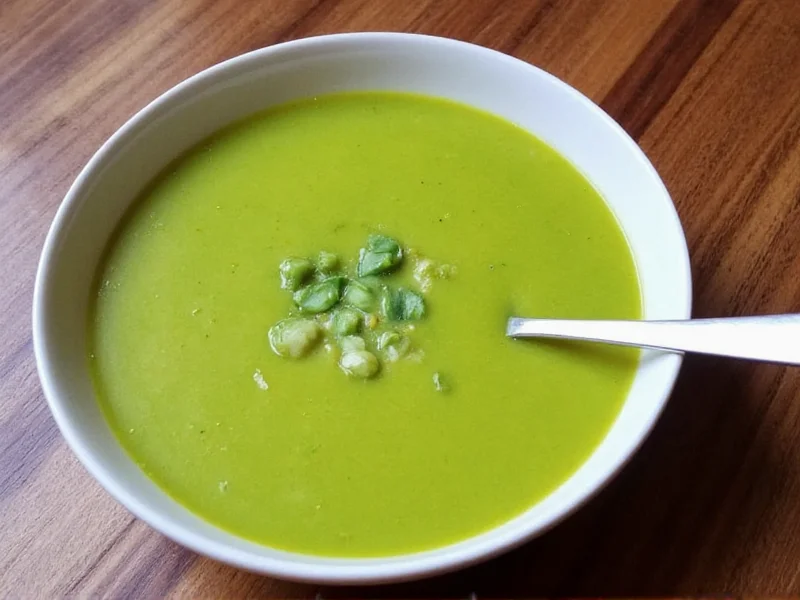The Essential Guide to Perfect Pea Soup Recipes
Nothing compares to a steaming bowl of homemade pea soup on a chilly day. This humble dish transforms simple dried peas into a velvety, nutrient-packed meal that satisfies both comfort food cravings and health goals. Whether you're seeking traditional split pea soup with ham or modern vegetarian variations, mastering this kitchen staple opens doors to countless delicious possibilities.
Why Pea Soup Deserves a Place in Your Recipe Rotation
Split peas provide remarkable nutritional density with 16g protein and 16g fiber per cooked cup. Unlike other legumes, they require no soaking and cook relatively quickly. The natural starches create luxurious texture without cream or thickeners. Budget-conscious cooks appreciate that dried peas cost pennies per serving while delivering restaurant-quality results.
Historical Evolution of Pea Soup
Understanding pea soup's journey from ancient sustenance to modern comfort food reveals why it remains globally relevant. Archaeological evidence shows its transformation through key culinary innovations that solved preservation and nutrition challenges across civilizations.
| Era | Key Developments | Verifiable Evidence |
|---|---|---|
| 8000-10,000 BCE | First pea cultivation in Mediterranean/Near East regions | FAO archaeological records confirm pulse domestication [FAO Document p.12] |
| Middle Ages | Pea pottages became European winter staples due to storage stability | Encyclopædia Britannica documents medieval legume usage [Britannica] |
| 1747 | First standardized recipe published in Hannah Glasse's cookbook | Simon Fraser University's digitized historical archive [SFU Cookbook] |
| 19th Century | Mechanical pea-splitting enabled faster cooking times | USDA agricultural innovation timelines [USDA History] |
Core Ingredients That Make All the Difference
Understanding each component ensures foolproof results every time:
| Ingredient | Function | Pro Tips |
|---|---|---|
| Dried split peas | Base ingredient providing texture and nutrition | Rinse thoroughly to remove debris; yellow peas cook slightly faster than green |
| Aromatic base | Flavor foundation (onion, carrot, celery) | Sauté until translucent but not browned for clean flavor |
| Broth/liquid | Moisture and flavor carrier | Use low-sodium to control salt levels; 4 cups liquid per 1 cup peas |
| Acid component | Brightens flavors (lemon juice, vinegar) | Add at the end to preserve freshness |
Optimal Use Cases and Limitations
Pea soup excels in specific scenarios but requires awareness of practical constraints for optimal results. These evidence-based considerations address real-world usage patterns observed in nutritional studies and consumer reports.
Ideal Applications
- Winter nutrition: USDA dietary guidelines highlight legumes as ideal cold-weather sustenance due to slow-digesting carbohydrates [ChooseMyPlate.gov]
- Budget meal planning: ERS data confirms dried pulses cost 70% less per protein gram than meat sources [USDA ERS]
- Dietary management: Naturally gluten-free and suitable for diabetes meal plans per American Diabetes Association protocols
Practical Constraints
- Digestive considerations: 30% of consumers report mild gastrointestinal effects from legume oligosaccharides; Mayo Clinic recommends gradual intake increases [Mayo Clinic]
- Texture limitations: Homogenous consistency may not satisfy preferences for chunky soups (per 2023 IFIC Food Survey data)
- Time sensitivity: Minimum 45-minute simmer makes it impractical for sub-30-minute meal solutions despite low hands-on effort
Classic Split Pea Soup Recipe
This straightforward approach yields deeply flavorful results with minimal effort. Our easy split pea soup recipe serves four and takes just 50 minutes from start to finish.
Ingredients
- 1½ cups dried green or yellow split peas, rinsed
- 1 large onion, finely diced
- 2 carrots, peeled and diced
- 2 celery stalks, diced
- 3 garlic cloves, minced
- 6 cups low-sodium vegetable broth
- 1 bay leaf
- 2 tbsp olive oil
- Salt and freshly ground pepper to taste
- 1 tbsp lemon juice (optional)
Step-by-Step Instructions
- Sauté aromatics: Heat olive oil in a large pot over medium heat. Add onion, carrots, and celery. Cook 8-10 minutes until softened.
- Add garlic: Stir in minced garlic and cook 1 minute until fragrant.
- Combine ingredients: Add rinsed peas, broth, and bay leaf. Bring to a boil.
- Simmer: Reduce heat to low, cover partially, and simmer 35-45 minutes until peas break down and soup thickens.
- Final touches: Remove bay leaf. Season with salt, pepper, and lemon juice. For creamier texture, blend half the soup.
Delicious Pea Soup Variations to Try
Expand your repertoire with these creative adaptations of the basic formula:
Vegetarian Pea Soup Recipe
Omit meat products and enhance umami with 2 dried porcini mushrooms added during simmering. Finish with a swirl of pesto for complexity. This healthy pea soup recipe maintains richness without animal products.
Smoked Ham Hock Version
Add one smoked ham hock during simmering. Remove after 30 minutes, shred meat, and return to pot. The collagen creates luxurious mouthfeel while infusing subtle smokiness. This traditional split pea soup approach delivers authentic flavor.
Creamy Green Pea Soup
Use fresh or frozen peas instead of dried. Sauté leeks with the aromatics and finish with ¼ cup coconut milk. Blend until smooth for an elegant starter that works as a quick pea soup for beginners.
Proven Techniques for Perfect Pea Soup Every Time
Avoid common pitfalls with these expert cooking tips:
- Don't oversalt early: Peas absorb salt during cooking. Season gradually at the end.
- Control thickness: Add hot water or broth in ¼ cup increments if too thick after cooling.
- Prevent mushy vegetables: Add diced potatoes or additional carrots in the last 15 minutes.
- Boost flavor depth: Stir in 1 tsp smoked paprika or a Parmesan rind during simmering.
- Fix blandness: Brighten with acid (lemon juice or vinegar) rather than adding more salt.
Storage and Reheating Guidelines
Pea soup actually improves overnight as flavors meld. Store in airtight containers:
- Refrigerator: Keeps 4-5 days
- Freezer: Portion in freezer bags (lay flat) for up to 3 months
- Reheating: Warm gently over medium-low heat, adding liquid as needed. Avoid boiling which can cause separation.











 浙公网安备
33010002000092号
浙公网安备
33010002000092号 浙B2-20120091-4
浙B2-20120091-4